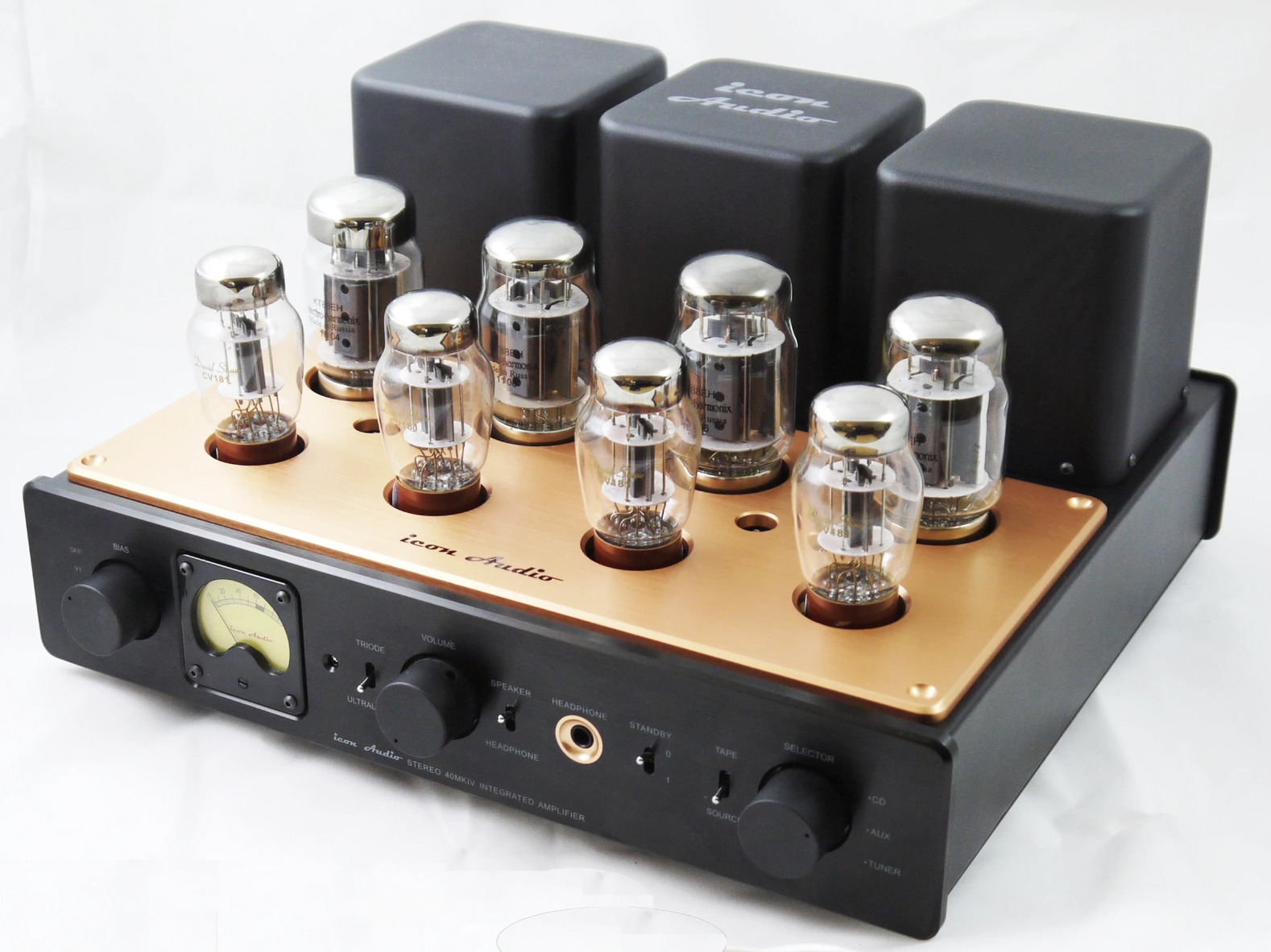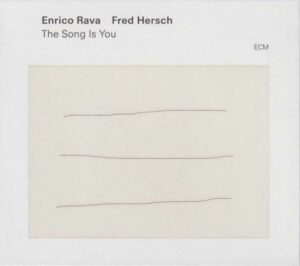
Icon Audio’s David Shaw tells me that the Stereo 40, Icon’s very first amplifier introduction in 2001, was inspired by the Leak Point One amplifiers, as well as various U.S. and Mullard designs. Being relatively inexpensive and successful enough, it gave Icon Audio the impetus to develop many other models. Yet, as David explains, the Stereo 40 always remained at the core of what the company does: Offer good value for the money and try to be better than the competition.
The Stereo 40 follows the tried-and-true approach of an Ultralinear (UL) push-pull output stage with the output transformer tapped at 40%. Both KT88 and EL34 versions are available, but the KT88 version appears to be more popular. The amp is switchable to triode mode via a toggle switch on the front panel, though as a safety precaution it is recommended that the amp be switched to standby mode before doing so. A tape-monitor loop is included, as is a motorized volume pot with a basic remote control. The 40 also features a headphone input that is connected directly to a low-power winding of the output transformer.
Much of the initial assembly is carried out in China, after which the amplifier is shipped to Leicester, England, and undergoes about 20 operations and mods before being valved and tested. Critically, the output transformer is wound in-house. Every amp and preamp ever built by Icon Audio undergoes a listening test prior to being shipped out, something David Shaw is quite proud of.
Under review is the Signature version of the amp, which is upgraded in several significant ways. It includes a quartet of the Gold Lion KT88 Russian reissue tetrodes, a quartet of the David Shaw white-base CV181 dual triodes, and a total of six Mundorf MCap EVO Silver/Gold in-oil coupling caps. Note that I haven’t auditioned the standard version, but honestly, after living with and enjoying the Signature edition for several weeks, I suspect that it significantly exceeds the sonic performance of the standard version.
A substantial design effort was aimed at achieving universal appeal—that is, ensuring compatibility with as wide a range of loudspeakers and playback systems as possible. Both 4- and 8-ohm taps are provided, and the customer is encouraged to try both in the context of his or her system. That’s because a loudspeaker’s nominal rating can be misleading, as impedance magnitude variations with frequency of about a factor of 10 are common for most box speakers. Icon Audio’s customer feedback indicates that most do prefer the 8-ohm taps.
The triode/UL switch offers additional flexibility in tuning a system. According to David, the design is centered around triode operation, and the reduced output of 25Wpc in triode mode should be enough for most domestic applications. His customer feedback indicates that most people run in triode mode all the time, though a minority do prefer UL. Ironically, as David puts it, many customers would not buy a 25W amplifier on its own.
There are, of course, sonic differences between the two modes of operation, but those attributes are very much affected by the choice of sensitivity setting via a back-panel toggle switch. In reality, this is a negative feedback (NFB) selector switch. The high-sensitivity setting equates to 6dB of NFB, while the low-sensitivity setting (122mV) equates to 12dB of feedback. The middle position gives zero NFB. Icon Audio’s customer feedback suggests that most people prefer the low-NFB/high-sensitivity setting, and even no NFB. This is an intriguing finding, as no NFB translates to a poorer damping factor and objectively higher distortion levels.
Experimenting with the NFB settings made for some instructive findings in the context of my own system. My least favorite settings turned out to be low sensitivity (max NFB) in UL mode. While the bandwidth window expanded with enhanced treble clarity and bass definition, image focus and soundstage transparency suffered. The overall presentation sounded a tad recessed and lacking in immediacy. The switch to high sensitivity did improve immediacy, but the most intense musical experience was to be had in the no-NFB position. The spatial impression improved dramatically. Soundstage depth perspective blossomed, and image focus became much more solid. The downside became obvious, though, as bass lines loosened up a bit.
In triode mode, choice of NFB setting was also obvious but a bit less critical. Bass response was better defined relative to UL at the no-NFB setting. And without any feedback the star attraction was a lovely, warm, and sweet tonality and brown-sugar-flavored textures that compensated nicely for dry recordings. In general, no feedback manifested itself in diminished treble extension, and a warmer less detailed presentation. The spotlight shifted to the lower midrange where the tonal gravitas of the CV181 shone through. Even the low-NFB setting was quite capable of delivering good sound with a superb boogie factor.
There was however one fly in the ointment. On wide-scale orchestral music, UL mode sounded much more dynamic with superior lower midrange weight and bass definition. Even on a high-sensitivity speaker like the Basszilla Platinum Edition, triode mode couldn’t generate as believable an impression of orchestral power. My favorite settings in this context ended up being UL mode/high sensitivity, where I was reminded of the textural sweetness of a good EL84-based amp but with the lower-midrange authority that is the hallmark of the 6SN7.
The tonal flexibility of the Stereo 40 became evident yet again when I switched to the Fleetwood DeVille loudspeaker. With its livelier balance, it benefitted from the no-feedback setting, cutting down the perceived treble extension a bit and resulting in a slightly softer presentation, but with billowing image outlines. However, there was more to it than just imaging. It resolved layers of orchestration exceptionally well, and low-level detail floated to the surface naturally without the help of any gratuitous upper-midrange brightness. It was far more revealing than that great and beloved classic UL amplifier, the Dynaco ST-70, which practically sounded fuzzy by comparison. One of the critical factors I look for in any power amp is a low annoyance factor. By annoyance I mean a bright disposition, obvious textural grain, or lack of transient speed and rhythmic conviction. The Stereo 40 excelled when it came to the music’s boogie factor, as well as refined grain-free-textures and fidelity to tonal colors. This was most evident on female voice, which was capable of floating in space with emotional expressiveness. Brahms’ orchestral works define beefy musical textures, and the Stereo 40 seemed to be the perfect partner, facilitating a most enjoyable delivery of the Double Concerto.
The Stereo 40 satisfies my appetite for glorious tube sound. Its confluence of musical attributes makes it sonically very attractive. In addition, it’s elegantly styled and easy to bias. I like it. I like it a lot. In fact, I’ll go even further and rank it among the elite of integrated tube amps I’ve reviewed regardless of price.
Specs & Pricing
Power output: 55Wpc Ultralinear mode at clipping; 30Wpc triode mode at clipping
Frequency response: 20Hz–20kHz at 8 watts (medium feedback, –0dB/–0.2dB; low feedback, –0.25dB/–0.5dB; no feedback, –2dB/–3dB
Input sensitivity: 122/280/825mV medium/low/zero feedback
THD: 0.15% typical at 8Wpc (low feedback)
S/N ratio: 85dB
Dimensions: 390 x 210 x 410mm
Weight: 22 kg
Price: $5295 (Signature); $4500 (Standard)
ICON AUDIO (UK) LTD
351 Aylestone Road
Leicester LE2 8TA UK
sales@iconaudio.com
iconaudio.com
AUDIOARCAN (Authorized Distributor)
sales@audioarcan.com
audioarcan.com
Associated Equipment
Speakers: Fleetwood Sound Company DeVille, Basszilla Platinum Edition MK II
Phono front end: Kuzma Reference turntable, Kuzma Stogi Reference 313 VTA tonearm, Clearaudio daVinci V2 MC Phono Cartridge; Wright Sound WPP200C phono stage; Sound Tradition MC-10 step-up transformer
Digital front end: MacBook Pro laptop running Audirvana 3.5 software; Qobuz streaming; Denafrips IRIS USB digital-to-digital converter, Soekris dac1421 DAC
Cable & interconnects: Acrotec, Mogami & Kimber KCAG interconnects; Wireworld Music Ribbon, Acrotec 6N and Kimber KCAG speaker cable
Accessories: Sound Application CF-X & TT-7 power line conditioners
Tags: AMPLIFIER ICON AUDIO INTEGRATED TUBED

By Dick Olsher
Although educated as a nuclear engineer at the University of Florida, I spent most of my career, 30 years to be exact, employed as a radiation physicist at the Los Alamos National Laboratory, from which I retired in 2008.
More articles from this editor





















